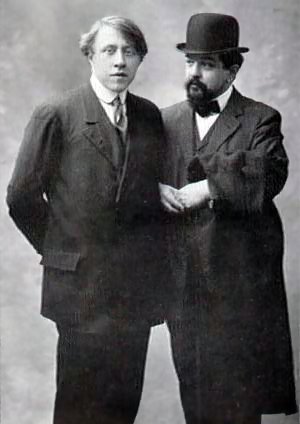André Caplet facts for kids
Quick facts for kids
André Caplet
|
|
|---|---|

André Caplet in 1910
|
|
| Born | 23 November 1878 |
| Died | 22 April 1925 |
| Nationality | French |
| Occupation | Composer |
André Caplet (born November 23, 1878 – died April 22, 1925) was a French composer and conductor of classical music. He was a close friend of Claude Debussy. Caplet helped Debussy by finishing the music for some of his pieces and arranging others for different instruments.
Contents
Early Life and Music School
André Caplet was born in Le Havre, France, on November 23, 1878. He was the youngest of seven children in a family that wasn't very rich. He started learning piano and violin when he was a child. By age 13, he was already playing in the orchestra at the Grand Théâtre in his hometown.
In 1896, he went to the Paris Conservatory, a famous music school, where he won several awards. To pay for his studies, he played in dance bands at night. Later, he started conducting, and he was very good at it right away. He became an assistant conductor for the Orchestre Colonne. In 1899, he became the music director at the Théâtre de l'Odéon.
Some of his early compositions were published in 1897. He won the important Prix de Rome in 1901. This prize allowed him to live at the French Academy in Rome until 1905, which helped him financially. Even while in Rome, he traveled to attend performances in other big cities like Berlin.
Music and Conducting Before the War
As a composer, Caplet wrote many pieces for voices and for small groups of instruments (chamber music). He also wrote several works for orchestra and a few piano pieces. He was one of the first composers to use the saxophone in his chamber music, like in his piece Légende (1903).
From 1910 to 1914, Caplet worked as a conductor for the Boston Opera Company in the United States. He was especially good at conducting French operas. He used this job to introduce new French music to American audiences. He conducted famous works by Debussy, including Pelléas et Mélisande.
World War I Service
When World War I started in 1914, Caplet joined the French army. He fought in the trenches at Verdun, a very difficult battle. He was wounded in May 1915 and later became a sergeant.
During the war, he worked on a piece called Les Prières (The Prayers). He finished it in 1917, and it was performed in a small church in Ham, France, with the sounds of distant artillery in the background. He left the army in 1919.
After the war, in 1919, he married Geneviève Perruchon. They had a son in 1920. From 1918 to 1919, he also taught conducting and music theory at a music school for U.S. military personnel in France.
After the War
After the war, Caplet focused mainly on composing, especially religious music. His Messe à trois voix (Mass for three voices) for female chorus was first performed in Sainte Chapelle in 1922.
Another important religious work was Le Miroir de Jésus (The Mirror of Jesus), composed in 1923. This piece is like an oratorio and features a main female singer with a female chorus. It uses texts that are meditations on the rosary. Caplet conducted its first performance in Lyon in February 1924.
Working with Debussy
André Caplet and Claude Debussy were very close friends. Caplet often helped Debussy, sometimes even acting as his translator. He also helped Debussy with the orchestration (arranging music for an orchestra) of several of his works, including parts of Le Martyre de saint Sébastien and La boîte à joujoux.
In 1911, Caplet created an orchestral version of Debussy's famous Children's Corner. He also orchestrated Clair de lune from Debussy's Suite bergamasque. These arrangements are some of Caplet's most well-known works today.
Death
In 1925, Caplet caught a cold. Because his lungs had been weakened from being gassed during his military service, he developed pleurisy, a serious lung illness. He died in Neuilly-sur-Seine, near Paris, on April 22, 1925, at the age of 46. He was buried in Montmartre Cemetery.
After his death, his wife organized many concerts to perform his music. In 1926, a sculptor named Jacques Zwobada created a monument to honor Caplet.
See also
 In Spanish: André Caplet para niños
In Spanish: André Caplet para niños


